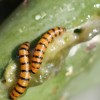 Since its arrival in the Florida Keys in 1989, this invasive species has become a serious threat to the diversity and abundance of Opuntia cactus in North America. The spread of this moth raises concerns about harm to rare opuntioid species (prickly pear and related cacti), the endangerment of wild opuntioids in the southwestern United States and Mexico and the consequent effects on entire desert ecosystems and economic hardship for communities in Mexico that cultivate and sell Opuntia. This 5-page fact sheet was written by D. H. Habeck, F. D. Bennett, and Christine Miller, and published by the UF Department of Entomology and Nematology, September 2012.
Since its arrival in the Florida Keys in 1989, this invasive species has become a serious threat to the diversity and abundance of Opuntia cactus in North America. The spread of this moth raises concerns about harm to rare opuntioid species (prickly pear and related cacti), the endangerment of wild opuntioids in the southwestern United States and Mexico and the consequent effects on entire desert ecosystems and economic hardship for communities in Mexico that cultivate and sell Opuntia. This 5-page fact sheet was written by D. H. Habeck, F. D. Bennett, and Christine Miller, and published by the UF Department of Entomology and Nematology, September 2012.
http://edis.ifas.ufl.edu/in213
Tag: Christine W. Miller
Heliconia Bug Leptoscelis tricolor Westwood (EENY511/IN914)
![]() Though not found in Florida, this insect has been used to examine insect behavior, sexual selection, plant-insect interactions, and color variation. Learn more in this 4-page fact sheet was written by Christine W. Miller, and published by the UF Department of Entomology and Nematology, December2011.
Though not found in Florida, this insect has been used to examine insect behavior, sexual selection, plant-insect interactions, and color variation. Learn more in this 4-page fact sheet was written by Christine W. Miller, and published by the UF Department of Entomology and Nematology, December2011.
http://edis.ifas.ufl.edu/in914